|
|
|
Sort Order |
|
|
|
Items / Page
|
|
|
|
|
|
|
| Srl | Item |
| 1 |
ID:
137030
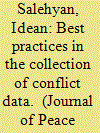

|
|
|
|
|
| Summary/Abstract |
Quality data is at the heart of all empirical research. Data collection on contentious politics, including civil war, terrorism, and protest has proceeded at a rapid pace over the last several years. This special section develops a set of best practices and offers advice to those involved in collecting conflict data as well as those who are regular users of such data. In this introduction, the process of data collection is considered, including source selection, information extraction or ‘coding’, and data sharing. A set of six rules is offered, which will hopefully guide others as they compile quantitative data on conflict processes.
|
|
|
|
|
|
|
|
|
|
|
|
|
|
|
|
| 2 |
ID:
110804
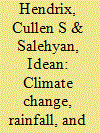

|
|
|
|
|
| Publication |
2012.
|
| Summary/Abstract |
Much of the debate over the security implications of climate change revolves around whether changing weather patterns will lead to future conflict. This article addresses whether deviations from normal rainfall patterns affect the propensity for individuals and groups to engage in disruptive activities such as demonstrations, riots, strikes, communal conflict, and anti-government violence. In contrast to much of the environmental security literature, it uses a much broader definition of conflict that includes, but is not limited to, organized rebellion. Using a new database of over 6,000 instances of social conflict over 20 years - the Social Conflict in Africa Database (SCAD) - it examines the effect of deviations from normal rainfall patterns on various types of conflict. The results indicate that rainfall variability has a significant effect on both large-scale and smaller-scale instances of political conflict. Rainfall correlates with civil war and insurgency, although wetter years are more likely to suffer from violent events. Extreme deviations in rainfall - particularly dry and wet years - are associated positively with all types of political conflict, though the relationship is strongest with respect to violent events, which are more responsive to abundant than scarce rainfall. By looking at a broader spectrum of social conflict, rather than limiting the analysis to civil war, we demonstrate a robust relationship between environmental shocks and unrest.
|
|
|
|
|
|
|
|
|
|
|
|
|
|
|
|
| 3 |
ID:
096565
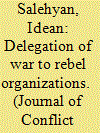

|
|
|
|
|
| Publication |
2010.
|
| Summary/Abstract |
States in an international dispute sometimes choose to attack their enemies with their own military forces but other times choose to empower domestic insurgent groups. What explains the decision to act through rebel proxies rather than directly engage a rival? Theories and empirical analyses of international conflict have adopted a state-centric bias, ignoring the substitution between direct uses of force and indirect action through rebel organizations. This note examines the decision to delegate conflict to rebels through the lens of principal-agent theory. While states support rebel groups to forgo some of the costs of conflict, they also lose a degree of foreign policy autonomy. Preliminary evidence of conflict delegation is presented, along with a number of empirically testable propositions. Finally, the consequences of delegation from the rebels' perspective are explored. This framework serves as a starting point for future research on rebel-patron interactions.
|
|
|
|
|
|
|
|
|
|
|
|
|
|
|
|
| 4 |
ID:
167276
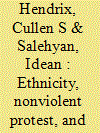

|
|
|
|
|
| Summary/Abstract |
Why do governments use deadly force against unarmed protesters? The government’s threat perception may be a function of the mobilization potential of the opposition and/or the size of the ruling elite’s support coalition. Given the high salience of ethnicity in African politics, governments that depend on small ethnic coalitions will see peaceful protests as more threatening, as the opposition may be able to draw on larger numbers of potential dissidents and excluded groups. Alternately, governments with larger, more homogeneous ethnic coalitions will find nonviolent mobilization less threatening and will be less likely to respond with deadly force. Using the Social Conflict Analysis Database, we demonstrate that as the size – and to a lesser extent homogeneity – of the ethnic ruling coalition grows, governments are significantly less likely to use deadly force against nonviolent protesters. This finding is robust to several operationalizations of the size of the government’s support coalition, the inclusion of other measures of ethnic demographics, and estimators that account for the hierarchical nature of the data. Threat perception hinges not only on dissident tactics but on their demands, their mobilization potential, and their capacity to impose costs on the government. This article demonstrates that the size and composition of the government’s ethnic support base matters as well.
|
|
|
|
|
|
|
|
|
|
|
|
|
|
|
|
| 5 |
ID:
133276


|
|
|
|
|
| Publication |
2014.
|
| Summary/Abstract |
Although some rebel groups work hard to foster collaborative ties with civilians, others engage in egregious abuses and war crimes. We argue that foreign state funding for rebel organizations greatly reduces incentives to "win the hearts and minds" of civilians because it diminishes the need to collect resources from the population. However, unlike other lucrative resources, foreign funding of rebel groups must be understood in principal-agent terms. Some external principals-namely, democracies and states with strong human rights lobbies-are more concerned with atrocities in the conflict zone than others. Multiple state principals also lead to abuse because no single state can effectively restrain the organization. We test these conjectures with new data on foreign support for rebel groups and data on one-sided violence against civilians. Most notably, we find strong evidence that principal characteristics help influence agent actions.
|
|
|
|
|
|
|
|
|
|
|
|
|
|
|
|
| 6 |
ID:
082409


|
|
|
|
|
| Publication |
2008.
|
| Summary/Abstract |
Many scholars, policymakers, and activists have argued that climate change will lead to resource competition, mass migration, and, ultimately, an increase in armed conflict around the world. This article takes issue with the `deterministic' view that climate change and resultant resource scarcities will have a direct impact on political violence. Rather, the effect of climate change on armed conflict is contingent on a number of political and social variables, which, if ignored by analysts, can lead to poor predictions about when and where conflict is likely. This article then discusses ways to improve research on the climate change-conflict connection and outlines broad policy suggestions for dealing with this potential problem. Scholars must communicate their findings with the policy community in order to come up with prudent solutions to this problem, while countering unnecessary rhetoric on both sides of the debate.
|
|
|
|
|
|
|
|
|
|
|
|
|
|
|
|
| 7 |
ID:
155186
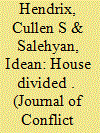

|
|
|
|
|
| Summary/Abstract |
Why do African regimes repress certain contentious challenges but not others? We argue that in addition to opposition claims and tactics, African regimes are especially likely to view challenges expressing ethnic and/or religious claims as threatening. However, in theorizing the decision to use repression, we relax the assumption that the state is a unitary actor. Leaders with a history of factionalism in their security forces face a delegation problem: orders to repress may not be followed or could even cause intraregime violence and/or defections. For this reason, states with divided security forces are less likely to enact repression. This potential for fracturing the regime will be greatest when the challenge has ethnic or religious claims and targets the state, implying an interactive effect. Using the Social Conflict in Africa Database, we find that regimes with a history of past military factionalism are generally less likely to use repression and are especially less likely to repress contentious challenges making ethnic or religious claims.
|
|
|
|
|
|
|
|
|
|
|
|
|
|
|
|
| 8 |
ID:
091000
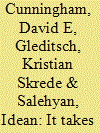

|
|
|
|
|
| Publication |
2009.
|
| Summary/Abstract |
Theories of conflict emphasize dyadic interaction, yet existing empirical studies of civil war focus largely on state attributes and pay little attention to nonstate antagonists. We recast civil war in a dyadic perspective, and consider how nonstate actor attributes and their relationship to the state influence conflict dynamics. We argue that strong rebels, who pose a military challenge to the government, are likely to lead to short wars and concessions. Conflicts where rebels seem weak can become prolonged if rebels can operate in the periphery so as to defy a government victory yet are not strong enough to extract concessions. Conflicts should be shorter when potential insurgents can rely on alternative political means to violence. We examine these hypotheses in a dyadic analysis of civil war duration and outcomes, using new data on nonstate actors and conflict attributes, finding support for many of our conjectures.
|
|
|
|
|
|
|
|
|
|
|
|
|
|
|
|
| 9 |
ID:
060810
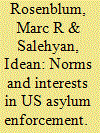

|
|
|
| 10 |
ID:
072258
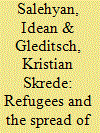

|
|
|
|
|
| Publication |
2006.
|
| Summary/Abstract |
Certain regions of the world experience more conflict than others. Previous analyses have shown that a civil war in one country significantly increases the likelihood that neighboring states will experience conflict. This finding, however, still remains largely unexplained. We argue that population movements are an important mechanism by which conflict spreads across regions. Refugee flows are not only the consequence of political turmoil-the presence of refugees and displaced populations can also increase the risk of subsequent conflict in host and origin countries. Refugees expand rebel social networks and constitute a negative externality of civil war. Although the vast majority of refugees never directly engage in violence, refugee flows may facilitate the transnational spread of arms, combatants, and ideologies conducive to conflict; they alter the ethnic composition of the state; and they can exacerbate economic competition. We conduct an empirical analysis of the link between refugees and civil conflict since the mid-twentieth century, and we find that the presence of refugees from neighboring countries leads to an increased probability of violence, suggesting that refugees are one important source of conflict diffusion.
|
|
|
|
|
|
|
|
|
|
|
|
|
|
|
|
| 11 |
ID:
077771
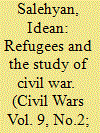

|
|
|
|
|
| Publication |
2007.
|
| Summary/Abstract |
This introduction examines the current literature on refugees and civil conflict. Rather than treating refugees as the unfortunate victims of conflict and the by-product of war, recent literature places forced migration squarely within the study of political violence. While humanitarian issues are certainly significant, refugees are also important political actors who play an active part in conflict dynamics. Three themes are considered here: conflict as a cause of forced migration, forced migration as a cause of conflict, and policy responses to refugee flows. This contribution also outlines promising areas for future research and introduces the articles in this special issue
|
|
|
|
|
|
|
|
|
|
|
|
|
|
|
|
| 12 |
ID:
164551
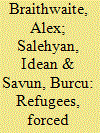

|
|
|
|
|
| Summary/Abstract |
Few issues in international politics have dominated public debates, both in domestic and international arenas, as much as refugee movements across borders in recent years. By the end of 2017, more than 68.5 million people – one in approximately every 110 people on the planet – had been displaced from their homes, either as internally displaced persons (IDPs) or as refugees, due to violent conflict, persecution, famine, or natural disasters. This article introduces a special issue on refugees, forced migration, and conflict. It describes the evolution of the international refugee regime and identifies theoretical and methodological advances in the relevant literature. It concludes with a discussion of the individual contributions to the issue, which seek to address gaps in the literature with respect to explaining motivations for refugee departures, understanding the relationship between refugee populations and political instability in host countries, and tracking public attitudes towards hosting refugee populations.
|
|
|
|
|
|
|
|
|
|
|
|
|
|
|
|
| 13 |
ID:
120168
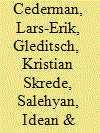

|
|
|
|
|
| Publication |
2013.
|
| Summary/Abstract |
A series of studies has shown that civil wars are caused not only by factors inside countries, but also by effects operating across state borders. Whereas a first wave of quantitative studies demonstrated that such effects make the "closed-polity" assumption untenable, more recently researchers have identified particular causal mechanisms driving conflict. Despite these recent advances, a central puzzle remains unresolved, namely why ethnic groups that at least in theory could count on support from large transborder ethnic kin (TEK) groups often have remained surprisingly peaceful, such as the stranded Russian populations in the "near abroad." We propose a theoretical framework that extends the analysis from the primary dyad between the incumbent and the challenger group by adding a secondary dyad that pits the incumbent against the TEK group. We postulate a curvilinear effect of the TEK group's relative size on conflict onset. Using a new data set on transnational ethnic links, we find that that the risk of conflict increases within the middle range of the size spectrum, consistent with our main hypothesis. This means that large TEK groups have a conflict-dampening effect, provided that they control their own state. Excluded TEK groups, however, are not associated with lower conflict probabilities.
|
|
|
|
|
|
|
|
|
|
|
|
|
|
|
|
| 14 |
ID:
078472
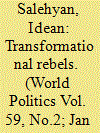

|
|
|
| 15 |
ID:
119639
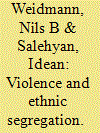

|
|
|
|
|
| Publication |
2013.
|
| Summary/Abstract |
The implementation of the United States military surge in Iraq coincided with a significant reduction in ethnic violence. Two explanations have been proposed for this result: The first is that the troop surge worked by increasing counterinsurgent capacity, whereas the second argument is that ethnic unmixing and the establishment of relatively homogenous enclaves were responsible for declining violence in Baghdad through reducing contact. We address this question using an agent-based model that is built on GIS-coded data on violence and ethnic composition in Baghdad. While we cannot fully resolve the debate about the effectiveness of the surge, our model shows that patterns of violence and segregation in Baghdad are consistent with a simple mechanism of ethnically motivated attacks and subsequent migration. Our modeling exercise also informs current debates about the effectiveness of counterinsurgency operations. We implement a simple policing mechanism in our model and show that even small levels of policing can dramatically mitigate subsequent levels of violence. However, our results also show that the timing of these efforts is crucial; early responses to ethnic violence are highly effective, but quickly lose impact as their implementation is delayed.
|
|
|
|
|
|
|
|
|
|
|
|
|
|
|
|
| 16 |
ID:
164561
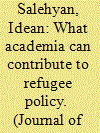

|
|
|
|
|
| Summary/Abstract |
This conclusion to the special issue highlights the role of scholars in advancing the public discussion about forced migration. As countries around the world are adopting increasing restrictions on the entry of refugees, academic research can help to dispel some of the myths and apprehensions regarding the risks that forced migration entails. While refugees may be linked to conflict and violence in limited circumstances, the research generally demonstrates that robust international cooperation to manage refugee settlements, provide adequate humanitarian assistance, and integrate refugees into host communities, among other policies, can help to mitigate potential risks. Directions for future research and analysis are also discussed. Forced migration scholars should endeavor to collect more individual-level data; seek to understand factors that exacerbate or reduce security risks associated with cross-border militancy; conduct research on the long-term integration of refugees; and seek to understand the causes and consequences of resettlement and repatriation policies.
|
|
|
|
|
|
|
|
|
|
|
|
|
|
|
|
|
|
|
|
|